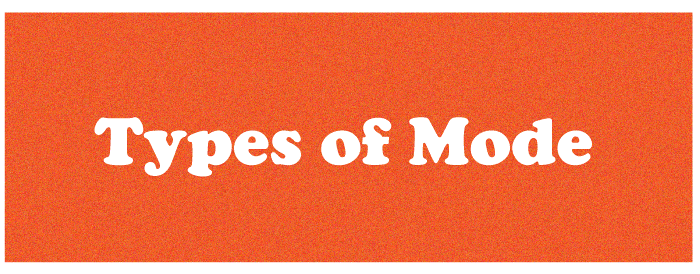Mode: What It Is in Statistics and How to Calculate ItIn statistics, the Mode is one of the values of the measures of central tendency. This number gives us a general notion of which data set elements are most likely to occur. As an illustration, one university provides students with ten different course options. The course with the greatest number of student enrolments will now be used as the Mode of the provided data. Simply put, the Mode provides information about the element that occurs most frequently in the given dataset. 
The most common repeated value or number in a dataset is referred to as the Mode. For instance, as it appears in the set of data, the most frequently out of all the other numbers, the number 20 is the Mode in the given list of numbers: 4, 4, 9, 6, 20, 20, 20, 28, 29, 34, 45. This is because the number 20 is repeated three times, but the others are not. Sometimes, it may be necessary to locate a value that appears more commonly in the dataset. In these situations, one may easily determine the Mode for the presented data set. A Mode value might or might not exist for a certain data set. It's also possible that there isn't a Mode for data if there is no repeated value. Additionally, the dataset can be found with one, two, three, or even more modes. The given dataset will help determine this. Types of Mode
Depending on how many modes a list includes, it could be unimodal, bimodal, trimodal, or multimodal. UnimodalUnimodal lists are lists of provided data having just one Mode. Example: Set A is: 12, 14, 14, 15, 16, 18, 20 The Mode of the data set 'A' is 14, as the 14 has been repeated more times (twice). Therefore, it is a Unimodal Mode Type, as there is only one Mode. BimodalBimodal lists are lists of data that have two modes. This indicates that there are two data elements with the maximum frequencies (of the same occurrences). Example: Set B is: 2, 2, 3, 4, 4, 5, 6, 8, 10 The modes of the given data set 'B' are 2 and 4, as 2 and 4 have repeated more times (twice). Therefore, it is a Bimodal Mode Type. TrimodalA data set is referred to as trimodal if it contains three modes. This indicates that there are three data values with the highest frequencies. Example: Set C is: 1, 1, 2, 3, 4, 5, 5, 6, 10, 10, 12 The modes of the given data set 'C' are 1, 5, and 10, as the 1, 5, and 10 have repeated more times (twice each). Therefore, it is a Trimodal Mode Type. MultiModalData sets are referred to as multimodal when they contain four or more modes. Example: Set D is: 50, 50, 55, 60, 65, 65, 70, 80, 80, 90, 100, 100 The modes of the given data set 'D' are 50, 65, 80, and 100, as 50, 65, 80, and 100 have repeated more times (twice each). Therefore, it is a Multimodal Mode Type. FormulaThe mode formula in statistics is used to determine the modal or Mode value of a given data collection. It is described as the value that frequently appears in a particular set. In other words, the Mode or modal value in a data collection is the number or value that occurs more commonly or has a high frequency. In addition to mean and median, the Mode is among the three measurements of central tendency. The most common element on the list is chosen to determine the Mode for ungrouped data. Let's now consider any given set of the data range, where "L" denotes the modal class's lower limit. Also, suppose that the class interval's size is indicated by "h", the modal class's Frequency is denoted by "fm", "f1" refers to the Frequency class before the modal class, and the Frequency of the class following the modal class is indicated as "f2". The highest frequency data interval, in this case, is the modal class. The following formula can be used to determine the Mode: How to calculate Mode?
The approach used to determine the Mode can vary based on the data that is provided (grouped or ungrouped). A grouped data is, as the name implies, data that is displayed in intervals. Graphs are a common way to display this type of data. Ungrouped data, in contrast, is information that can be displayed as a table. As a result, the available data can be classified into two categories: Grouped and Ungrouped. Let's examine how to get the Mode for both grouped and ungrouped data. Mode for Ungrouped DataOne should first sort the data values in either descending or ascending order and then look for repeated values and their Frequency to determine the Mode for ungrouped data. The modal value for the provided data is defined as the observation having the highest Frequency. Example 1: Determine the modal value for the given collection of information. 14, 15, 18, 20, 28, 15, 20, 15, 12, 14, 18, 16, 22, 25 Answer: The most frequently appeared number out of all the other numbers given in the data set is the Mode. Organising the provided data collection in ascending order, we have the below set: 12, 14, 14, 15, 15, 15, 16, 18, 18, 20, 20, 22, 25, 28 Here, we obtain 15 three times, 20, 18, and 14 twice a piece, whereas the other values only appear once. Therefore, 15 is the Mode for the provided data set. Example 2: Suppose a clothing company manufactured Shirts of different sizes as given below in the frequency distribution:
We need to find a Mode. Answer: one must first identify the variables that have the largest Frequency, as the variable with the largest frequency is the Mode. In the given table, the number 38 has the maximum Frequency (i.e., the highest number of shirts). Therefore, 38 is the Mode for the provided data set. Mode for Grouped DataIn the case of the grouped data set, one needs to identify the class interval with the highest Frequency. It's also known as the modal class. Determine the class size in the next step. The calculation is performed by deducting the upper limit from the lower limit. Next, find the frequencies of "fm", "f1", and "f2". Use the Mode formula to determine the Mode in the last step. The grouped data formula for Mode is: Mode = L+h (fm-f1)/((fm-f1) + (fm-f2)), where:
Example: Suppose the following data set:
Solution: Modal Class = 15-20 (this is the class that has the maximum Frequency) Lower Limit of the Class ("L") = 15 The class Interval's Size ("h") = 5 The Modal Class Frequency ("fm") = 10 The frequency preceding the Modal class ("f1") = 5 The frequency following the Modal Class ("f2") = 8 Finding the Mode, Substitute the values as mentioned above in the below formula: Mode = L + h (fm-f1)/((fm-f1) + (fm-f2)) = 15 + 5 (10-5)/( (10 - 5) + (10 - 8) ) = 15 + 5 (5)/ (5+ 2) = 15 + 25 / 7 = 15+ 3.6 = 18.6 Therefore, the Mode value for the given table is 18.6. The Mode formula mentioned above can also be presented or written in another form, like below: Mode = l0 + h ( f1 ? f0) / ( 2f1 ? f0 ? f2 ) Where,
Advantages of Mode
Disadvantages of Mode
Important Points to remember in the context of ModeThe following list of key points will enable in summarising the subject and idea covered in the context of Mode:
|
 For Videos Join Our Youtube Channel: Join Now
For Videos Join Our Youtube Channel: Join Now
Feedback
- Send your Feedback to [email protected]
Help Others, Please Share









